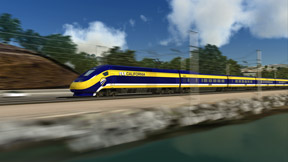"This is us telling it like it is to the public -- no sugar-coating, no baloney," said Dan Richard, one of two appointees Gov. Jerry Brown made to the California High-Speed Rail Authority last summer.
The business plan will be publicly released Tuesday during a news conference at the California State Railroad Museum in Sacramento.
It also calls for retaining the most controversial aspect of the proposed rail line -- starting construction in the Central Valley. Critics want to start in more populated areas of southern or northern California in case money runs out before the full system is finished, which they worry would create a "train to nowhere."
But $3.5 billion in federal funding is contingent upon the Central Valley route, and construction must begin before October 2012. That does not leave enough time for new engineering proposals and environmental reviews to be conducted elsewhere, the plan says.
The new business plan says the system will be built in sections than can operate independently and make money, even if no more track were ever built, Richard said. Planners hope each new section will generate momentum -- and private investment -- to complete subsequent sections.
The business plan also says the high-speed rail system will use existing rail lines to carry passengers on the final legs into San Francisco and the Los Angeles basin. Doing so instead of building new high-speed lines not only saves money but makes the project more politically palatable by reducing neighborhood objections.
Sen. Joe Simitian, D-Palo Alto, had pushed to use existing tracks in urban areas. He said that change in the plan was good news, along with more realistic cost projections in the new report, which he had not seen.
"The good news is they're at least coming up with a real number; the bad news is that's a pretty scary number," Simitian told The Associated Press.
The plan is being released at a politically sensitive time for the rail project.
Governors and lawmakers in several other states have been backing away from costly high-speed rail plans because of ongoing state budget deficits caused by the recession. Florida, Wisconsin and Ohio all pulled back on their rail plans, leading the Obama administration to turn over their federal money to California.
California voters and the Obama administration already have committed nearly $13 billion to the state's high-speed rail project, but the plan has faced increasing scrutiny about whether it will ever become reality.
The new business plan said it offers a more realistic cost estimate based on inflation over 20 years and estimates as much as $20 billion in private financing. Richard said it "will be a true public-private partnership."
The plan also calls for the rail segments to be phased in over several years, as is the case with other high-speed rail projects around the world. If the segments are built faster, the cost would decrease, the report said.
"Importantly, the phased approach means that decisions made today won't tie the state's hands tomorrow," the report states.
Even under the most conservative ridership projections, the report said the rail system would have a net operating profit.
It pegs ridership at anywhere from 7.4 million to 10.8 million riders by 2025 for an initial southbound phase. Even at low ridership projections, the project would have a net operating profit of $352 million a year, the report said.
The average ticket between San Francisco and Los Angeles would cost $81 in non-adjusted dollars, with express trains completing the trip in less than three hours.
The Democratic governor asked his two summer appointees to take a hard look at the project. Richard spent 12 years on the board of the Bay Area Rapid Transit system, and retired Bank of America executive Michael E. Rossi also is Brown's jobs adviser.
Under the revised business plan, initial construction would start with a $5.2 billion "spine" from Fresno to Bakersfield to be completed in 2017. The line would then be extended further north or south -- from Merced to Palmdale, in the Los Angeles basin, or from Bakersfield to San Jose.
The first 130-mile segment would create about 100,000 jobs in the hard-hit Central Valley, according to the report. Building the entire system would generate about 1 million jobs.
The report notes that while the $98.5 billion tab seems high, California's growing population would otherwise require about $170 billion in new infrastructure, such as freeways and airport runways.
Brown said in August that he still supports the plan to link San Francisco with Los Angeles and Anaheim by 2020, but his Department of Finance is expected to review the proposal in detail before he signs off.
Late Monday, Brown issued a statement saying the first section in the Central Valley will create jobs "at a time when we really need them." He also noted that a high-speed rail line will accommodate the state's population growth "without the huge expense and intractable problems of massive highway and airport expansion."
State Sen. Alan Lowenthal, D-Long Beach, a one-time proponent of the project and chairman of the Senate select committee on high-speed rail, has said California should consider returning the $3.5 billion in federal grants and halting the project unless the authority lays out a clear path to finance, build and operate the system. He said California taxpayers must not be on the hook for unexpected cost overruns.
Some lawmakers were being briefed on the plan Monday night.
In a report issued last July, a peer-review committee created as part of the 2008 ballot measure that approved $9 billion in bonds said later phases of the rail project rely almost entirely on federal, state and local money that might never materialize. That poses a risk that whatever is started will not be finished and might be of little use to most California residents, that review said.
The Legislature, which returns in January, must approve the proposal, along with Brown.
